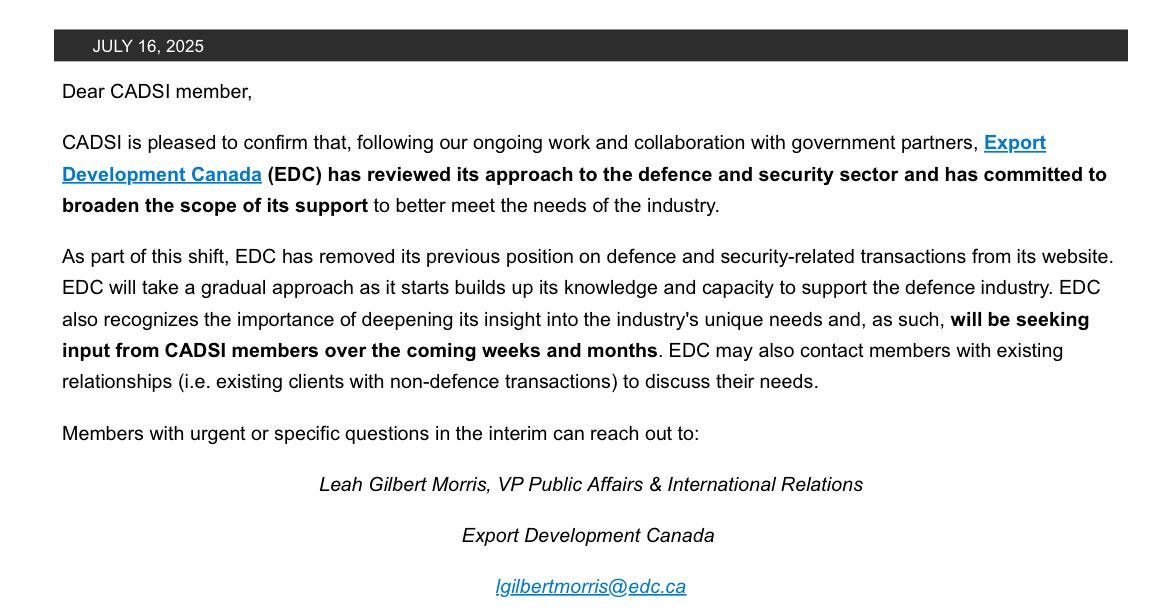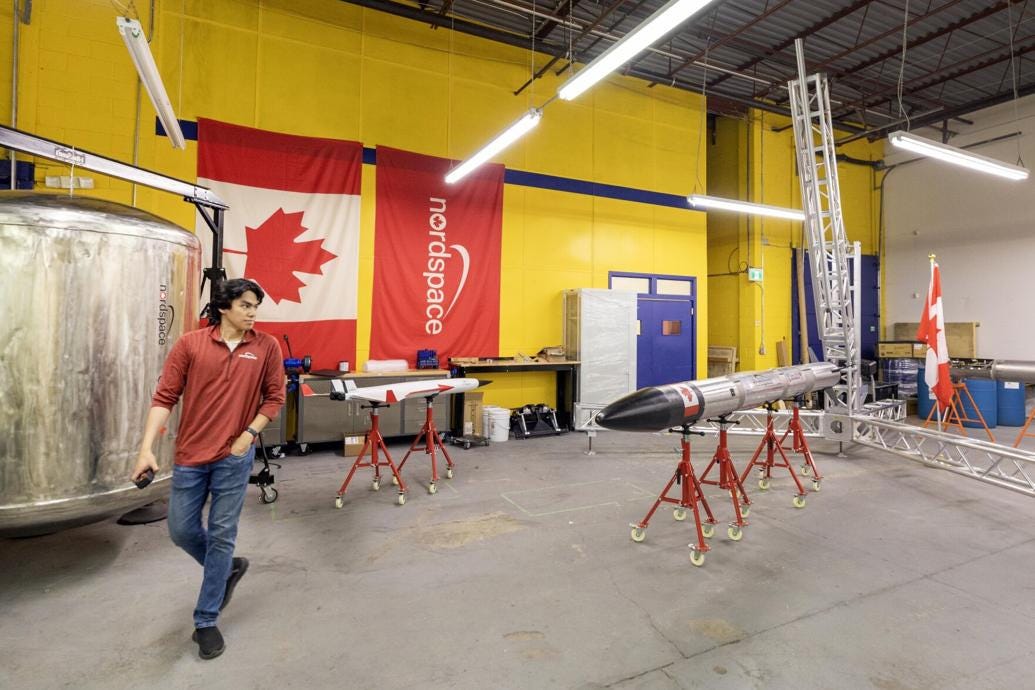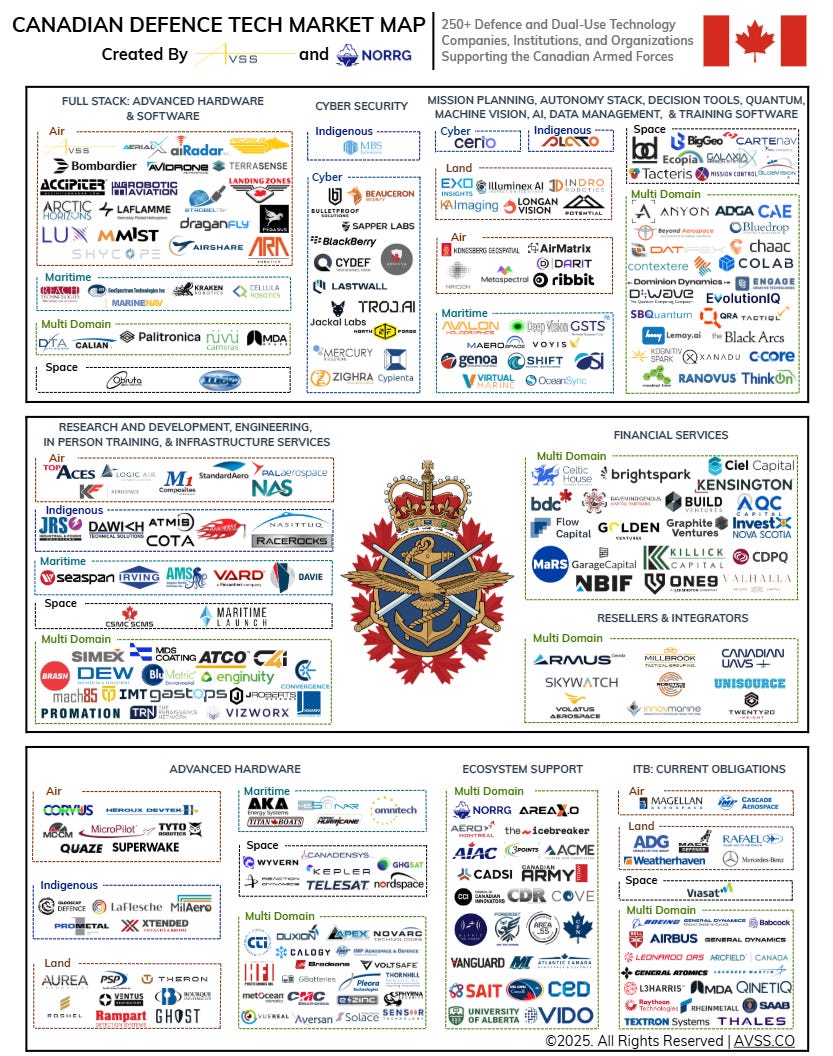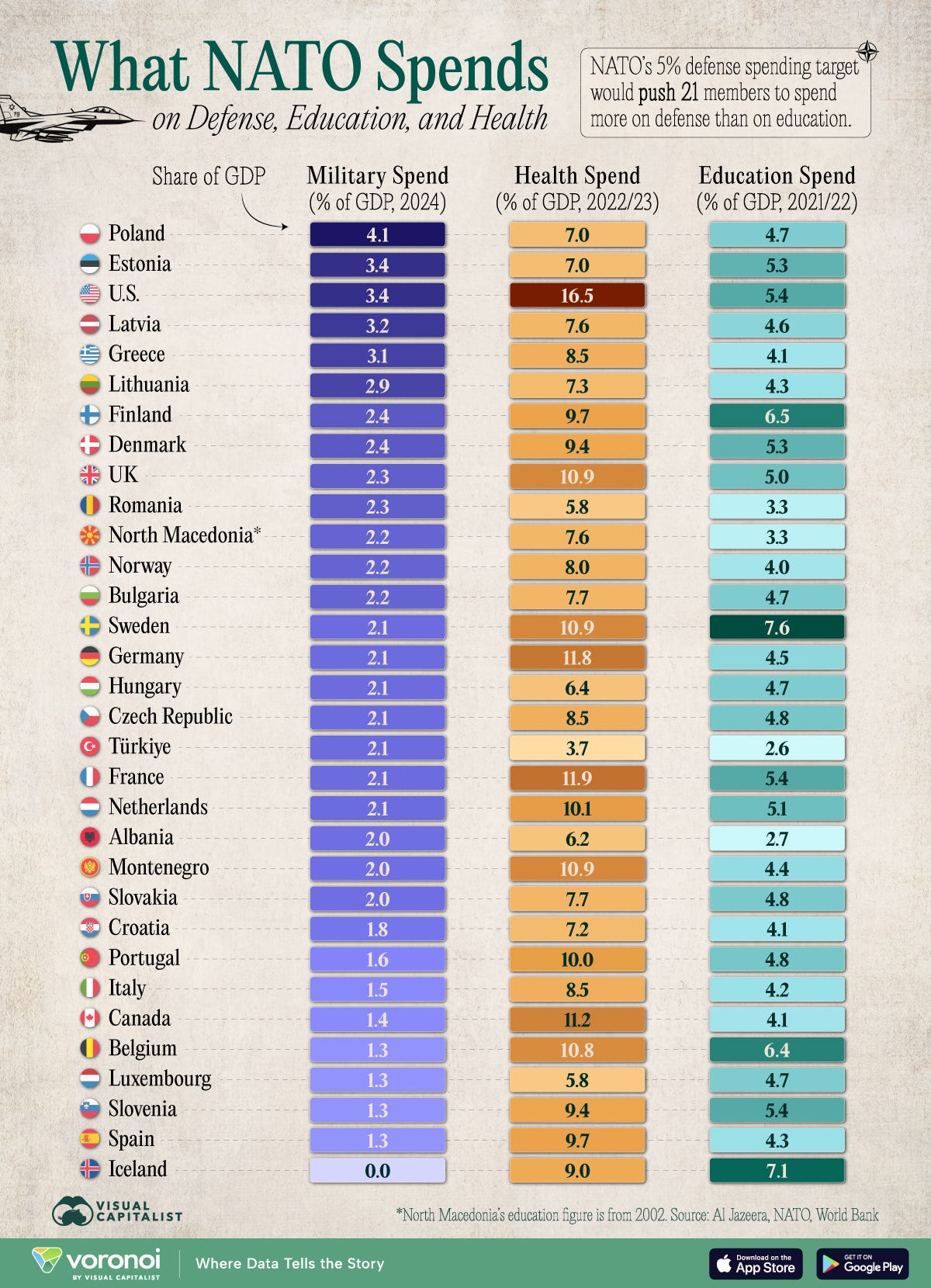Spy Games
Innovators reimagine the spy game for a world with no cover
Our readers at CSE and CSIS have encouraged us to look upstream of defence, to think about how tech is changing how we inform and predict before a threat materializes.
🎯 Three-Shot Burst
Spying goes high-tech
A profound transformation is taking place in the world of intelligence. For spies, there is literally no place to hide. Millions of cameras around the world record every movement and catalogue it forever. Every action leaves digital tracks that can be studied and linked with others. Your cellphone and social media accounts tell the world precisely who and where you are. Further, attempts at concealment can backfire in the digital age.
Reality check: Data is the new battleground, and startups lead in innovation. Former agency pros and military vets are founding startups (Lumbra, Cape, and Strider, which employs David Vigneault, former head of Canadian intelligence) that leapfrog government capabilities. Open-source data, advertising data (ADINT), and commercial analytics now outpace government spies.
Seemingly innocuous metadata can expose top-secret operations. Ad industry data mining once found Special Operations sites in Syria just by commercial phone app data, catching the military off guard.
Oh Canada: For a country like Canada, the challenge is even more acute. We’re not the CIA. We don’t have the budget or global footprint. But we’re still playing in the same sandbox, especially with our Five Eyes partners. So we’re increasingly focused on building smarter digital tools and finding private sector partnerships that can move faster than government R&D cycles allow. Most innovation is happening outside official channels. One example: intelligence officers who operate without any overt ties to their government, and need full-spectrum digital cover. You can’t just invent a LinkedIn profile and a Gmail account and call it a day. Digital cover now needs to be lived-in, layered, and deeply embedded over time. And that takes years of prep, which is tough to scale.
Bottom line: The tension between traditional tradecraft and new realities shows that many of the old methods don’t just feel outdated, they’re operationally risky. Ubiquitous technical surveillance (UTS) — cameras, AI, cell phone tracking, and social data — means every move is recorded and analyzed. Trying to disappear actually makes you more suspicious.
But human intelligence (HUMINT) isn’t dead. It’s just becoming rarer and more high-stakes. When a country does run HUMINT ops, it’s because the payoff is massive and there’s no other way to get the intel.
The crossover between national security and commercial intelligence via startups is only going to grow.
Related:
“Brazilian professor” arrested in Norway turns out to be poorly disguised GRU officer Mikhail Mikushin — the Canada-connection will startle you
Canada is becoming digitally subservient to the U.S. in the global economy
Keyboard warriors: French military expands specialized OSINT reserve battalion with two new companies focused on open-source intelligence collection and analysis
Before joining cabinet, public safety minister wrote immigration support letters for terror group ‘member’… Defence minister calls extremist plot charges ’disturbing’
📋 Procurement Update
Mapping the Canadian dual-use technology ecosystem
[Editor’s note: Thanks to the 300+ companies that have already taken the survey!]
Canada is ramping up military spending to meet NATO targets. This is an enormous opportunity to propel the growth of our domestic tech sector through defence procurement.
Canada’s innovators are building world-class technologies. But too often, they fly under the government’s radar — we are often told that Canadian companies don’t have the necessary capacity to meet Canada’s defence needs, like $100M worth of the aforementioned binoculars.
The Department of National Defence (DND) and Canadian Armed Forces (CAF) want to change that, and it begins with mapping our private sector defence capacity.
Our first-of-its-kind industry survey, in partnership with the Council of Canadian Innovators (CCI), is your chance to put your company’s products and services on the government’s radar.
The federal government has asked CCI to build a market map of Canadian companies that can help serve Canada’s defence needs. The Icebreaker is pleased to formally partner with CCI to build this database of Canada’s strategic defence capabilities.
By sharing your insights, you’ll help us map the Canadian dual-use tech ecosystem and unlock new opportunities for collaboration, funding, and national impact.
If your company has technology that could be used in defence, please take 5 minutes to fill out the survey. CCI and The Icebreaker will be sharing the information collected with the Government of Canada:
Related:
File under Positive Developments: EDC has communicated to CADSI members its evolving position on defence financing
💾 Canada’s first Defence Tech Hackathon
September 20 in Toronto
We are excited to announce that the DMZ at TMU will host the hackathon!
The Defence Tech Hackathon is a catalyst to jumpstart a world-class ecosystem that builds sovereign capability in Canada. Our goal is to attract top talent, rapidly prototype real-world solutions, and bridge the gap between innovators and military end-users.
By forging new startups, building critical networks, and injecting a sense of urgency into defence innovation, this hackathon lays the foundation for Canada to compete and win on the global stage. We aim to advance the grassroots spirit of current and soon-to-be defence tech entrepreneurs.
We are still finalizing details, but here is what we know so far:
We will aim to rapidly prototype dual-use tech that solves real operational gaps for the Canadian Armed Forces
We are considering a challenge for a prototype platform that ingests multi-modal sensor feeds (satellite, UAV, radar, acoustic, etc.) and fuses them for real-time Arctic domain awareness
If you’re a software engineer who is defence-curious, this could be for you. We are looking for folks with domain expertise/experience in one or more of: defence, dual use tech (software and technology that can be used for both civilian and military applications), or Arctic operations; or who have any prior experience with multi-modal sensor fusion and real-time data platforms
🤝 Sovereign Capability
Space Race
Including the European Space Agency, of which France, Germany, Italy and the U.K. are member states, Canada is the only G7 nation without orbital launch capability.
Without our own launch capability, Canada will always be dependent on US or European partners, especially when US-Canada relations are rocky.
NordSpace is trying to change that, even as the company roots for its competitors to succeed at the same time.
NordSpace plans to launch the suborbital “Taiga” rocket in August as a test; and build the much larger “Tundra” rocket for full orbital capacity by 2027.
NordSpace isn’t just building rockets, they’re developing a Newfoundland spaceport and working on satellite tech. Founder Rahul Goel self-funds NordSpace because Canadian capital markets are too risk-averse for this kind of moonshot venture.
Related:
Think global, act local?: Feds partner with Australia on $6-billion Arctic radar project in 'slap in the face' to Canadian company [Editor’s note: There are two Canadian firms that have similar solutions. One is in the PM’s own riding.]
Is there recourse? Trade tribunal calls for freeze on multimillion-dollar defence contract after complaints it favours U.S. supplier
Advantage Canada?: Why Canada’s federal government keeps talking about quantum tech with Xanadu’s Christian Weedbrook
Data boom: GeologicAI cashes in on data centre boom with $60.5-million CAD Series B [Editor’s note: No Canadian capital in the round?]
Canadian drone maker ZenaTech expands US presence “earlier than expected” in response to Trump policies
Op-ed argues Canada should commit 20 per cent of its defence budget to R&D
Mapping the ecosystem, by Josh Ogden:
Policy changes: On July 14, Canada changed its “open by default” procurement approach to ensure equitable market access for Canadian federal suppliers and to prevent “non-reciprocating countries” from benefiting from federal procurement opportunities. Trade lawyers contend that the policy might actually end up limiting the ability of some Canadian companies from bidding on government contracts
Government of Canada is seeking CUAS solutions that can detect Micro and Mini Uncrewed Aerial Systems (UAS) in an urban environment with systems that can be integrated into the broader military command and control systems. DND is also launching a challenge procurement in the UAS space to develop attritable interceptors. This comes on the heels of Minister McGuinty’s visit to NORAD, where he confirmed that the Government has removed all restrictions on air and missile defence of Canada
July 25 is the deadline to apply for COVE DIANA’s Naval Technology Innovation Challenge
Canada is getting closer to satellite connectivity on every phone… The North is Canada’s secret weapon against Donald Trump… TD strategist says ‘we are inching closer to a wartime economy’ as nations stockpile resources
It takes a village:
We are pleased to highlight the newly-launched ventures and products of some friends of the newsletter, who are providing critical ecosystem support to our growing defence tech sector:
Lagassé & Lennox, focused on in-depth research, evidence-informed advice, and media campaigns in the national security, intelligence, and defence sectors
Commo Agency, focused on marketing for defence
Montreal Institute for Global Security has launched a global impact fund to enable proactive and rapid response to global security threats
Sparkgeo, a geospatial partner for some of the biggest brands in technology:
⚔️ Combat Readiness
Is the US ready for the next war?
With global conflicts increasingly shaped by drones and A.I., the American military risks losing its dominance.
Post–Cold War downsizing and consolidation have left the U.S. with a brittle, slow-moving military–industrial complex. Just five major prime contractors remain.
Current procurement prioritizes marginal technical improvements over speed and adaptability, resulting in weapons that take years (and billions) to field, often using components from geopolitical rivals like China.
America struggles to resupply allies (e.g., Javelin, Stinger missiles for Ukraine), revealing critical manufacturing and supply chain vulnerabilities.
Bottom line: Programs like the Replicator initiative aim to accelerate drone development, but deep-rooted process and cultural barriers remain.
Related:
Bad to worse: Most of NATO drones are worthless in Ukraine because they can't keep up with development speed
Is it fixable?: Two days inside the movement to reindustrialize and rearm America
The product is the factory:
The Coming Revolution in Military Tech: Anduril Industries builds ‘attritable’ aircraft like autonomous fighter jets, which are cheaper to lose than regular airplanes
Missile-Defence-as-a-Service?: A novel procurement idea for ensuring NATO countries can be armed swiftly… CSIS (not that one!) with a new report on mesh sensing for air and missile defence
Ukrainian UGV manufacturer Tencore raised $3.7M from MITS Capital, with a valuation at over $40M… Booz Allen Hamilton announced that it is tripling its venture capital commitment from $100 million to $300 million into US defence tech
It’s a trap: Reliance on dual-use technology is a trap that risks ceding America’s technological advantage to its adversaries
Chips vs. Rare Earths: Nvidia to resume sales of highly desired AI computer chips to China. The US says the renewed sale of H20 chips in China was linked to a trade agreement made between the two countries on rare earths
Defence supply chains are brittle, and most rely on rare earths controlled by China
The US Department of Defense will guarantee a minimum price for America's only domestic rare earth miner MP Materials at nearly twice the current market level
VR health: Retired Vice-Admiral Darren Hawco, a friend of the newsletter, writes about tech advances to support military members and their families with augmented health services
Visual appeal:
🍁 Canada’s Inaugural Defence Power 50 List
Until August 11, we are taking nominations for Canada’s inaugural Defence Power 50 List. The list will recognize the most influential leaders and up-and-comers in the defence community who are critical to making the changes Canada needs.
The selection of this inaugural 2025 list is co-chaired by Erin O'Toole, Glenn Cowan, Philippe Lagassé, Sheldon McCormick, and Eliot Pence.
Nominate someone we should know about today!
Related:
Erin O’Toole pays tribute to fellow veteran Marc Garneau
🔫 Hot Shots
Breaking the ice: Your favourite Canadian defence innovation network with a mention in the Globe & Mail, to frame up how Ottawa’s massive defence spending is set to transform the industry
Same, Same but Different?: Taking Inspiration from the US Defense Innovation Unit (DIU), the UK is launching its own… The US is thinking about how to advance beyond its DIU… France’s defence innovation agency has built a one-stop shop to tap startups
Dirty Money: Is Chinese money undermining Canada’s Arctic?
Keeping Pace: A breakdown of the latest US defence budget
Not-Rad?: An explainer on why U.S. — not Canadian — fighter jets responded to alleged hijacking of B.C. plane [Aside: the Americans know we are better pilots than them]
Hangin’ out: DND to start construction on new F-35 hangars despite review
How now brown cow: How should Canada rearm itself? Fix aging bases, buy submarines, air-defence systems, experts say
Attention!: This October, step into the boots of the soldiers from the 36 Canadian Brigade Group with an exclusive, immersive behind-the-scenes experience designed to deepen public awareness for the Canadian Armed Forces
Throwback: A 20-year-old report by Jack Granatstein still has lessons for Canada
Where to begin? Canada's Defence Capability Blueprint provides information about defence procurement and contracting opportunities in an online searchable format
Who will bear the cost of military spending increase? When pressed, Canadians prefer debt to taxes to pay for it
Stonks go up: Europe’s arms makers get a boost from Trump’s NATO demands
European VC funding is on track for a decade low. But not in defence, where venture capitalists seek a ride on the defence bandwagon
Aerospace & Defence report from B Riley Securities
Reward points: Urkaine’s E-Points program has already become a game-changer in the war by introducing the “the more you destroy — the more you get” philosophy to military supply
Land force: Germany negotiates to acquire up to 7,000 combat vehicles from Rheinmetall in historic land forces expansion
⚔️ Meme Warfare
We can make fun of ourselves. We know Clausewitz isn’t a SaaS tool.
🤝 Meet the Defence Tech Community
The Icebreaker is hosting another meetup, this time on the West Coast
Defence Tech Patio Drop In, August 14 in Victoria, B.C.: Sign up here to join VCs, founders, operators, defence primes, and the defence-curious, over a few cold beers on a sunny patio.
If you’ve got battlefield intel, classified tips, or just want to call in an airstrike on our typos, hit “reply” and sound off. Whether it’s a new tech sighting, a rumour from the mess hall, or feedback on our comms, we want your SITREP.









